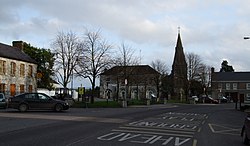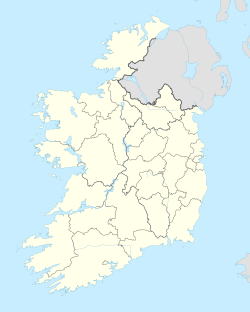Kilworth
|
Kilworth Cill Uird
|
|
|---|---|
| Village | |

Kilworth village
|
|
| Location in Ireland | |
| Coordinates: 52°10′35″N 8°14′39″W / 52.176399°N 8.2441702°WCoordinates: 52°10′35″N 8°14′39″W / 52.176399°N 8.2441702°W | |
| Country | Ireland |
| Province | Munster |
| County | Cork |
| Elevation | 72 m (236 ft) |
| Population (2011) | |
| • Urban | 21 |
| Time zone | WET (UTC+0) |
| • Summer (DST) | IST (WEST) (UTC-1) |
| Irish Grid Reference | R833027 |
Kilworth (Irish: Cill Uird) is a village in north County Cork, located about 2 kilometres north of Fermoy near the river Funcheon. The M8 Cork–Dublin motorway passes nearby. Kilworth has an Army Camp, located on the R639 regional road between Mitchelstown and Fermoy.
The name Kilworth comes from Irish (Gaelic) "Cill Úird", literally meaning "church of the order". In the seventeenth and eighteenth centuries, Kilworth was a notable settlement on the old Dublin to Cork road, prior to the construction of the T6/old N8/R639 road from Fermoy to Cashel and from Cashel to Urlingford between 1739 and the mid-nineteenth century. Numerous accounts and maps dating from the 1680s tell of armies and travellers journeying from Fermoy to Clogheen and onwards to Dublin via Kilworth and Kilworth Mountain.
Kilworth's most notable resident was David Richard Pigot, who became Chief Baron of the Irish Exchequer and one of the foremost Irish judges of his day. He was born in Kilworth about 1796, son of John Pigot, a doctor and his wife Margaret Nagle. David's eldest son John Edward Pigot, one of the founders of the National Gallery of Ireland, was also born in Kilworth.
Teagasc has an agricultural research facility based at Moorepark, just outside Kilworth. The village is within commuting distance of many centres of employment, including Cork city.
...
Wikipedia

